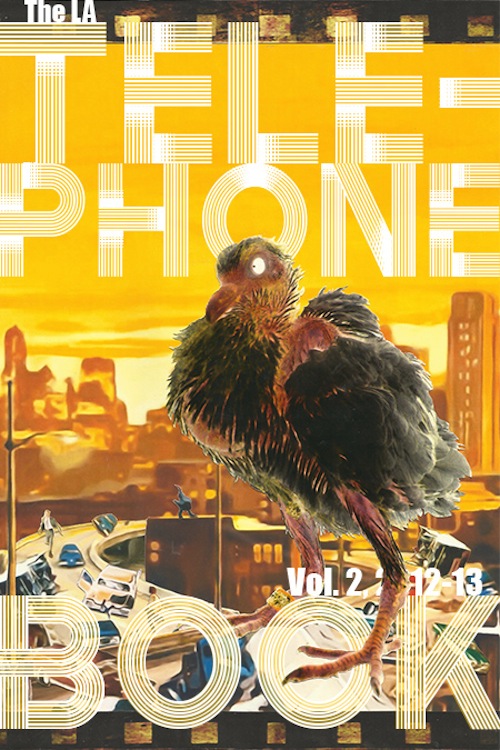Announcing Volume 2 of The L.A. Telephone Book: New Work From Southern California

The Los Angeles poetry scene has never seemed particularly attracted to cohesion (and more on that below), but finalement, what you had no idear you were waiting for: The L.A. Telephone Book Vol. 2 2012-13 is a collection of new work by contemporary Southern California writers and text-artists compiled and designed by poet and digital artist Brian Kim Stefans. About:
The collection was created based on a semi-open call to writers and artists for up to 7 pages of work, set in 6 x 9 in .pdf format, which were then assembled into the present file. All choices were made by the artists and presented as they created it. Several artists contributed notes and statements about their work.
The book includes work by Janice Lee, Will Alexander, Diana Arterian, Deborah Meadows, Molly Bendall, Andrew Choate, Geneva Chao, Daniel Tiffany, and more. Available as a FREE PDF. Volume 1 was released in 2012.
And if this really does pique your curiosity, please check out Brian's selection of “lost” Los Angeles poets, done back in July for a feature in Paul Revere's Horse. His take on "major poetry cities" and those considered otherwise:
Poetry in the United States is focused in two major urban centers, New York and San Francisco. While other cities have developed poetry “scenes,” it is these two cities that seem perennially able to renew their poetic identities, with fresh influxes of young writers and a substantial group of older, decidedly “established,” mentors to maintain a sense of continuity with previous generations and their aesthetic strategies. Other cities, such as Philadelphia, Boston, Washington, D.C., and Chicago, also have a number of writers with national reputations, and their traditions are old and deep, especially in the case of Boston, but none of them have risen to or maintained the status of a pole of activity, at least since the time of the New Americans, when an axis seemed to develop between New York and San Francisco. Of course, it is impossible to determine the exact parameters of a “major poetry city,” the term itself being inelegant, and writers in these cities (and others, such as Austin, Seattle, Lawrence, or Atlanta) don’t often sense a lack, or if they do, it is a productive one. However, these writers usually recognize that they are not in one of the cities associated with poetry—they identify as underdogs, loyal to their local scenes and perhaps even energized by their marginality.
A city not often counted in any of these rubrics is Los Angeles. One of the largest American cities, once dubbed the “city of the future,” it is legendary for its highways, the movie industry, miles of quasi-suburban “villages,” racial strife and wild economic disparities, and general air of being an outpost on the tail end of the country. It has also managed to nurture and sustain a number of poets who have attained national reputations, but nonetheless the city hasn’t acquired, to most eyes, an identifiable poetic “style” that illustrates to the readers of its poetry what the city means as an intellectual, artistic center, a stark contrast to the various styles of visual art—including the pop-inspired works of Baldessari and Ruscha, the architecture of Richard Neutra, the found art/assemblage aesthetics of Wallace Berman and Edward Kienholz, the performance art of Chris Burden, Paul McCarthy, and Mike Kelley, and the murals of ASCO—that have identified L.A. for decades. There are many reasons for this—there really aren’t many “older poets” active on the scene, for example, and many Los Angeles writers are quite happy to be working without an active local “tradition” anyway—but I won’t go much further on speculating why this is the case.


